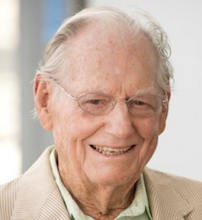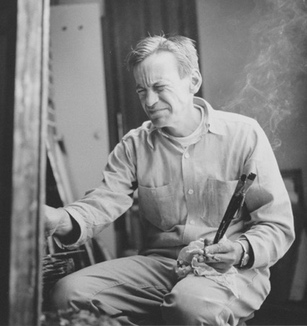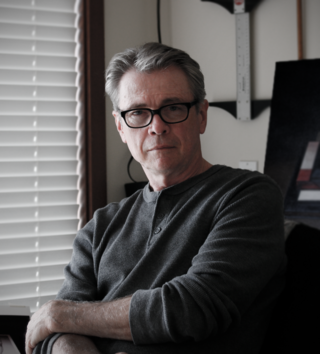Related Research Articles

Morton Wayne Thiebaud was an American painter known for his colorful works depicting commonplace objects—pies, lipsticks, paint cans, ice cream cones, pastries, and hot dogs—as well as for his landscapes and figure paintings. Thiebaud is associated with the pop art movement because of his interest in objects of mass culture, although his early works, executed during the fifties and sixties, slightly predate the works of the classic pop artists. Thiebaud used heavy pigment and exaggerated colors to depict his subjects, and the well-defined shadows characteristic of advertisements are almost always included in his work.

Richard Diebenkorn was an American painter and printmaker. His early work is associated with abstract expressionism and the Bay Area Figurative Movement of the 1950s and 1960s. In the late 1960s he began his extensive series of geometric, lyrical abstract paintings. Known as the Ocean Park paintings, these paintings were instrumental to his achievement of worldwide acclaim.

David Park was an American painter and a pioneer of the Bay Area Figurative Movement in painting during the 1950s.
The San Francisco Arts Commission (SFAC) is the City agency that champions the arts as essential to daily life by investing in a vibrant arts community, enlivening the urban environment and shaping innovative cultural policy in San Francisco, California. The commission oversees Civic Design Review, Community Investments, Public Art, SFAC Galleries, The Civic Art Collection, and the Art Vendor Program.
The Bay Area Figurative Movement was a mid-20th Century art movement made up of a group of artists in the San Francisco Bay Area who abandoned working in the prevailing style of Abstract Expressionism in favor of a return to figuration in painting during the 1950s and onward into the 1960s. Spanning two decades, this art movement is often broken down into three groups, or generations: the First Generation, the Bridge Generation, and the Second Generation.

Manuel John Neri Jr. was an American sculptor who is recognized for his life-size figurative sculptures in plaster, bronze, and marble. In Neri's work with the figure, he conveys an emotional inner state that is revealed through body language and gesture. Since 1965 his studio was in Benicia, California; in 1981 he purchased a studio in Carrara, Italy, for working in marble. Over four decades, beginning in the early 1970s, Neri worked primarily with the same model, Mary Julia Klimenko, creating drawings and sculptures that merge contemporary concerns with Modernist sculptural forms.
Robert Carston Arneson was an American sculptor and professor of ceramics in the Art department at University of California, Davis for nearly three decades.
Roy De Forest was an American painter, sculptor, and teacher. He was involved in both the Funk art and Nut art movements in the Bay Area of California. De Forest's art is known for its quirky and comical fantasy lands filled with bright colors and creatures, most commonly dogs.
Wally Bill Hedrick was a seminal American artist in the 1950s California counterculture, gallerist, and educator who came to prominence in the early 1960s. Hedrick's contributions to art include pioneering artworks in psychedelic light art, mechanical kinetic sculpture, junk/assemblage sculpture, Pop Art, and (California) Funk Art. Later in his life, he was a recognized forerunner in Happenings, Conceptual Art, Bad Painting, Neo-Expressionism, and image appropriation. Hedrick was also a key figure in the first important public manifestation of the Beat Generation when he helped to organize the Six Gallery Reading, and created the first artistic denunciation of American foreign policy in Vietnam. Wally Hedrick was known as an “idea artist” long before the label “conceptual art” entered the art world, and experimented with innovative use of language in art, at times resorting to puns.

David Gilhooly, was an American ceramicist, sculptor, painter, printmaker, and professor. He is best known for pioneering the Funk art movement. He made a series of ceramic frogs called FrogWorld, as well as ceramic food, planets, and other creatures.

William Thomas Wiley was an American artist. His work spanned a broad range of media including drawing, painting, sculpture, film, performance, and pinball. At least some of Wiley's work has been referred to as funk art.
Roger Edward Kuntz was a highly accomplished Southern California landscape painter and a member of the Claremont Group of painters - professors and graduates of Pomona College, Scripps College, and the Claremont Graduate School. A figurative artist with an eye for abstract form, he won critical acclaim for striking compositions that transform an unusual array of subjects, including tennis players, domestic interiors, freeways, road signs, bathtubs and the Goodyear Blimp. A retrospective exhibition of his work, at the Laguna Art Museum in Laguna Beach, CA in 2009, was aptly titled "Roger Kuntz: The Shadow Between Representation and Abstraction". In the exhibition catalogue, curator Susan M. Anderson wrote: "Kuntz's work of the late 1950s and early 1960s quintessentially embodied the experimentation, fragmentation, and paradox in American culture of the time."
William Theophilus Brown was an American artist. He became prominent as a member of the Bay Area Figurative Movement.
Roland Conrad Petersen is a Danish-born American painter, printmaker, and professor. His career spans over 50 years, primarily in the San Francisco Bay Area and is perhaps best-known for his "Picnic series" beginning in 1959 to today. He is part of the Bay Area Figurative Movement.

Guy Louis Diehl is an American artist best known for still life paintings and prints, many of which incorporate direct references to historically significant artists and artworks.

Susan Landauer (1958–2020) was an American art historian, author, and curator of modern and contemporary art based in California. She worked for three decades, both independently and as chief curator of the San Jose Museum of Art (SJMA) and co-founder of the San Francisco Center for the Book. Landauer was known for championing movements and idioms of California art, overlooked artists of the past, women artists, and artists of color. She organized exhibitions that gained national attention; among the best known are: "The San Francisco School of Abstract Expressionism", "Visual Politics: The Art of Engagement", and retrospectives of Elmer Bischoff, Roy De Forest, and Franklin Williams. Her work was recognized with awards and grants from the International Association of Art Critics, National Endowment for the Arts and Henry Luce Foundation, among others. Critics, including Roberta Smith and Christopher Knight, praised her scholarship on San Francisco Abstract Expressionism, De Forest, Richard Diebenkorn, and Bernice Bing, among others, as pioneering. In 2021, Art in America editor and curator Michael Duncan said that "no other scholar has contributed as much to the study of California art." Landauer died of lung cancer at age 62 in Oakland on December 19, 2020.
Jim Melchert was an American visual artist, arts administer, and professor. He known for his ceramics and sculptures. Melchert was part of the Funk art movement.

Jerrold Curtis Ballaine is an American painter, sculptor, draftsman, photographer and educator, presently Emeritus Professor of Art at the University of California, Berkeley.{1}https://jerroldballaineart.com/resume.htm
Oliver Lee Jackson is an American painter, sculptor, draftsman, printmaker, and educator. His art studio is in Oakland, California. He was a professor at the California State University, Sacramento from 1971 until 2002, and developed a curriculum for the Pan African Studies program at the school.
Katherine Sherwood is an American artist living and working in the San Francisco Bay Area, California who is known for paintings that explore disability, feminism, and healing, and for her teaching and disability rights activism at the Department of Art Practice at the University of California, Berkeley.
References
- 1 2 3 4 5 6 Landauer, Susan; Gerdts, William H.; Trenton, Patricia (2003-11-10). The Not-So-Still Life: A Century of California Painting and Sculpture. University of California Press. p. 187. ISBN 978-0-520-23938-8.
- 1 2 "Christopher Brown". KQED Spark. 2006-05-31. Archived from the original on 2015-10-18. Retrieved 2021-10-12.
- ↑ Bolt, Thomas (April 1, 1990). "Christopher Brown by Thomas Bolt". BOMB Magazine. Archived from the original on 2017-11-04. Retrieved 2021-10-12.
- ↑ Whiting, Sam (2011-03-30). "Catching up with painter Christopher Brown". SFGATE. Retrieved 2021-10-12.
- 1 2 3 4 "Christopher Brown". FAMSF Search the Collections. 2018-09-21. Retrieved 2021-10-12.
- 1 2 "Story Theme: The Influence of Memory, Subject: Christopher Brown, Discipline: Visual Art (Painting)" (PDF). SPARK Educator Guide – Christopher Brown. KQED. 2006. Archived (PDF) from the original on 2021-10-23.
- ↑ Rosa, Rene Di (1999). Local Color: The Di Rosa Collection of Contemporary California Art. San Francisco, California: Chronicle Books. p. 58. ISBN 978-0-8118-2376-0.
- ↑ Ayres, Anne (1986). 2nd Newport Biennial: The Bay Area. Newport Harbor Art Museum. pp. 10, 53. ISBN 978-0-917493-07-2.
- ↑ Landauer, Susan (2017-04-15). Of Dogs and Other People: The Art of Roy De Forest. Univ of California Press. p. 182. ISBN 978-0-520-29220-8.
- ↑ "Brown, Christopher". SFMOMA. Retrieved 2021-10-12.
- ↑ "Dutch Daybreak, 1990". The Metropolitan Museum of Art. Archived from the original on 2016-03-05. Retrieved 2021-10-12.
- ↑ "Farmers' Almanac". Cleveland Museum of Art. 2018-10-31. Archived from the original on 2019-12-27. Retrieved 2021-10-12.
- ↑ "Christopher Brown, Eighty-second Street, 1993". National Gallery of Art (NGA). 1993. Archived from the original on 2021-10-29. Retrieved 2021-10-13.